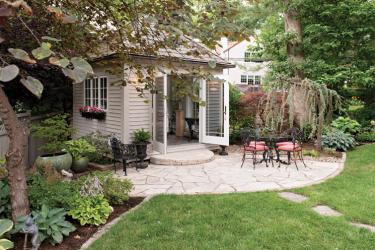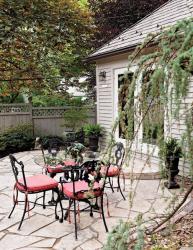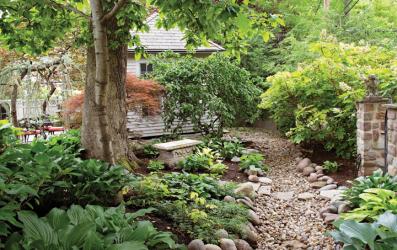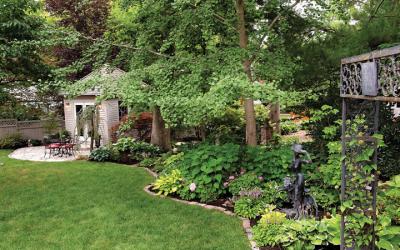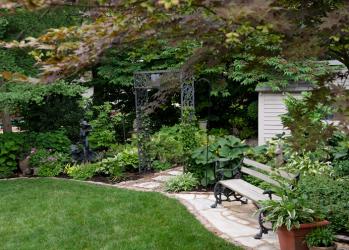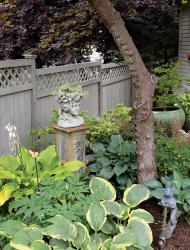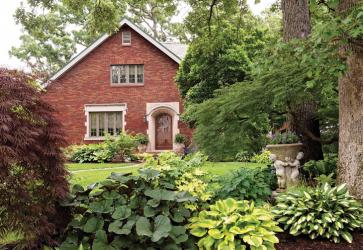To call Janelle Criscione’s Webster Groves garden “lush” hardly does it justice. The word should at least be capitalized, if not rendered in boldface type.
Sheltered by a canopy of mature oaks and ginkos that transform the sun’s rays into dappled shade, the garden glows with all the tints and tones of rich green that nature, and an extensive collection of hostas, can provide.
Numerous vibrantly flowered tree peonies and azaleas add brilliance in the spring. The pinks and purples of hydrangea blossoms offer pops of color during the heat of summer. Understory trees, selected for their interesting shapes and architectural value, bring rhythm and flow to beds and pathways. Throughout the landscape sculptural accents, collected throughout the past 25 years, blend garden walks with art tours. Two statues of young women, which Janelle purchased from a Palm Beach estate, are placed in the front yard in honor of her granddaughters Audrey and Rachel. Old cobblestones thread their way through the garden and draw visitors into the landscape, particularly highlighting the more rustic areas.
“Nestled in a corner of the back yard,” in the words of Janelle’s late husband, Dr. James Criscione, “you will find a sweet little garden house, the perfect spot to spend a quiet afternoon reading, sipping a glass of wine and planning a new garden project.” It is, according to Janelle, a potting shed that grew, eventually transformed with heat, air conditioning and a slate floor into a livable space. “When you’re a gardener, you have to have a place to mix dirt,” Janelle recalls. “I had my eye on a little house for several years, and I finally convinced my husband to build it. It just got nicer and nicer, and pretty soon it had nice windows and a nice slate floor. Then it was too nice to put dirt in.” Now furnished with a comfortable armchair, foot stool, upholstered day bed and cubby holes filled with gardening books, the space is the perfect place to briefly cool off when tending the garden on a hot day. When the work is done, “There is nothing like being out there in the afternoon and seeing all that dappled shade in the back yard with all my books, planning new projects,” she says. What was once a chicken coop is now her potting shed.
Janelle credits her love of gardening to the time in the late-1980s when she and her husband, who were not yet married, would take walks from property he owned on Berry Road to downtown Kirkwood. Their route down Adams Avenue took them by the home of Edgar Denison, author of the Field Guide to the Wildflowers of Missouri and great advocate of landscaping with native plants. “He was an absolute jewel, and he was always out working in his yard,” Janelle says recalling her many conversations with the famed naturalist. “He was a wealth of information and very generous with his time.”
When the couple eventually married, their wedding took place in the backyard garden of their Webster Groves home, another testament to Janelle’s love of gardening.
Busy concentrating on the interior of the house, they did little with the yard other than remove the vast amounts of invasive honeysuckle that choked the space. “What jumpstarted me,” Janelle recalls, when going back to the origins of her landscape of today, “was helping my son-in-law make a raised play area for his girls because their yard was very wet.” When the dirt he ordered was considerably more than needed for the project, Janelle claimed the extra soil and began gardening in earnest. Not long after that, she gained access to a load of cobblestones and made good use of those as well.
Janelle’s first project was the creation of a dry creek bed to deal with a drainage problem at the rear of the yard. Next came the berms in the front yard. Along the way she joined the Hosta Society. She credits that membership with the incredible variety of hostas in her garden. “Gardeners are great people,” she says. “They are always willing to share. You can go to Home Depot and buy hostas, but it is just not the same.”
Her love of tree peonies dates from her childhood in Richmond, MO, and a man who lived down the street who grew the showy blossomed shrubs from seed. “The minute I saw them, I knew they were something I wanted,” she recalls. She now has 15 different specimens planted throughout her landscape. While the blossoms appear somewhat similar, tree peonies are taller and broader than their more common relatives, herbaceous peonies, and have woody stems that remain above ground. They grow best in partial sun, part shade or even full shade with air circulation most important to their cultivation. Janelle’s dappled shade garden is the perfect spot for them to thrive.
The architectural shape of many of the smaller trees in her yard is no accident. Several come by their interesting shapes naturally such as the crooked-branched contorted filbert, also known as Harry Lauder’s walking stick, or the weeping Blue Atlas cedar. Others are made more interesting by Janelle’s deft pruning learned from the Botanical Garden’s Horticultural Supervisor Ben Chu, a master of Japanese pruning techniques, who has studied in Japan and taught classes throughout the United States.
She credits the use of leaf mulch, a tip given to her by Edgar Denison, as one of her gardening secrets. Not only does it improve soil fertility as it decomposes, “it is much lighter than other mulches and easier for me to work with. I spread about 4 to 6 inches of it on my beds and I keep a dumpster full of it to use throughout the summer when I’m planting,” she explains.
Janelle acquired many of the sculptures, sprinkled throughout her landscape, on winter trips to Florida. “I was always on the lookout for things, and we drove so I could put things in the car and bring them back. There is always room for one more sculpture or one more plant,” she says with a laugh.
What draws her to gardening, Janelle feels, is the sense of renewal it provides. “When you plant something in the fall and it comes up in the spring, it makes you know the world is good. There is a spiritual thing about a garden. I think you know that God is there because of the garden. As we have been so isolated (due to Covid-19), the garden has been my salvation.”


